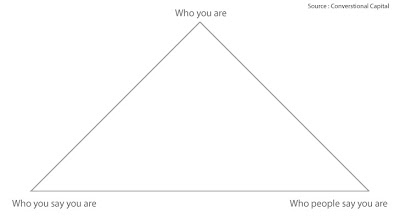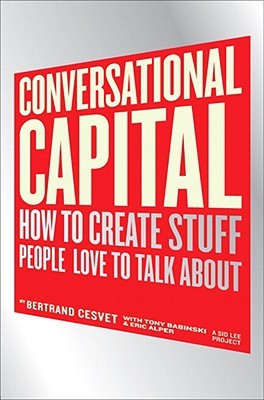
By now, many of you would have heard of buzz and viral marketing, experiential marketing, and the art of conversational marketing.
Some of you may have also learned about three of the most important marketing ideas in the 2010s (and 2020s): creating a Purple Cow, pushing an idea over the Tipping Point, and the almost religious need to use social media in marketing.
So what’s the newest trick in the marketing bag?
Enter Conversational Capital, a book written by Bertrand Cesvet, Tony Babinski, and Eric Alper from experiential brand collective SID LEE.
According to the authors, Conversational Capital can be seen in many leading “talkable” brands like Cirque du Soleil, Apple, adidas, Red Bull, IKEA, and the Volkswagen Beetle.
It is demonstrated by brands that are able to design and create products and services that are so meaningful and engaging that their consumers feel personally invested in sharing stories about them — often without prompting.
At its core, the concept of conversational capital is embedded in the Eight Engines of Conversational Capital.
Let us dive into each and every one of these rituals now.
#1 Rituals
These are behaviours or rites that one engages in to mark an “exalted” experience.
Examples include the clowns interacting with audiences prior to each Cirque du Soleil show and the squeezing of a fresh lime into a Corona beer bottle.
A special category—Initiation—may even involve some degree of work (think of the first time you went swimming). Resonant rituals help to enrich experiences. They also assist to make your brands more distinctive and memorable.
#2 Exclusive Product Offering (EPO)
This occurs when a consumer experience is specially customised and individualised such that it appears to be tailored just for you. When it is created in such a personal fashion, it helps to strengthen the salience of the brand.
Examples include having monogrammed napkins with your name on them (for first time diners at the Regent Hotel in Hong Kong), and Starbucks allowing you to order coffee anyway you like it while writing your name on the cup.
Over-delivery is what happens when a brand goes out of the way to strengthen customer engagement. It includes features, services or benefits that “Wow” customers and create talkability.
#3 Myths
Yes, urban brand legends are always good for storytelling.
As an engine of Conversational Capital, myth is about creating a strong brand story that captures the attention and imagination beyond just product features and benefits.
Examples included how Steve Jobs founded Apple, what the 11 secret herbs and spices in KFC’s chicken are, and the “secret ingredient” in Coke.
#4 Relevant Sensory Oddity (RSO)
Here, Conversational Capital meets experience design.
As much as possible, you should surprise your consumers by stimulating his/her range of senses: sight, sound, taste, scent, touch and feel. This should be carefully curated and orchestrated to be brand relevant and resonant in a meaningful way.
Examples are Herman Miller’s uniquely designed (and expensive) Aeron Chair, Abercrombie & Fitch (famous for the buzzworthy nude male torso in Singapore) for their anti-retail store environment, and Innocent Drinks with healthy juices in six ounce bottles.
#5 Icons
These have strong symbolic value and can be anything (or anyone) rich in positive association and evocative power: places, buildings, people, logos, product designs, packaging, labels, and more.
Steve Jobs, Jeff Bezos and Bill Gates are icons. Mark Zuckerberg and Jack Ma are icons. So is Sir Richard Branson.
Products and logos can also be icons. They include the Coca-Cola bottle, McDonald’s golden arches, KFC’s Colonel Sanders, and the Red Bull can.
#6 Tribalism
Tribes are formed when you’re able to build customer communities and draw like-minded folks together. Often, you foster your unique tribes by telling them brand stories which helps to form and affirm their collective brand identities.
Customer Capital happens when your company or brand effectively facilitates the formation of groups and communities based on their tastes, preferences and principles.
The Build-a-Bear retail workshop forms tribes among lovers of customised cuddlies. Harley Davidson riders themselves have formed strong tribes (most notably the Harley Owners Group or HOGs).
Apple users are also known to be highly tribal, with members of the Mac Cult users group forming a special bond with each other.
#7 Endorsement
Endorsement is about getting your consumers to freely and independently advocate your brand without any solicitation or endorsement. It does require your product or service experience to be so remarkable that others will freely talk about you.
In other words, if you build the experience and make it compelling enough, “the magic will happen.” Of course, this also requires you to identify who your top fans are and to find ways to recognise them for their support.
(And yes, it is not about paying celebrities or dignitaries to speak up for you.)
#8 Continuity
The final engine of Conversational Capital is about ensuring that you walk the talk, say what you mean, and mean what you say.
It is about coherence, integrity, and consistency across every step of the way, as shown in this figure below from the book:

Source: Conversational Capital
To adhere to this, you’ll need to ensure that what you do and what you say are aligned to each other.
How to Implement Conversational Capital in Your Brand
To bring the eight engines of conversational capital to life, the book provides tips on designing and implementing a solution.
a) Designing Conversational Capital
On design, you should start by identifying what your brand truly is about and develop your brand story.
Study what your potential customers are interested in, and dive into what they truly want.
To expand your horizon, assemble a multidisciplinary and culturally diverse team. Doing so helps your company (and brand) to multiply your cultural references and go beyond tried-and-tested cliches.
You should also build a culture which dares to be different—think like an entrepreneur and use the 8 engines above to guide your design.
b) Implementing Conversational Capital
Design is good, but how do you implement these ideas in your organisation?
Here, the authors suggest that you should package your ideas into a workable prototype, roll it out to test your market receptivity, monitor progress, and improve your product or service design along the way.
(Read The Lean Startup for a good way to do so.)
Conclusion
While the ideas aren’t entirely new—many of the concepts appear to be old wine in new wineskins—I like how the authors were able to assemble the disparate marketing ideas into a coherent whole.
As a trigger for action, Conversational Capital does set you thinking about how experiences can be better designed, looking at your consumer’s experience pathways while emphasising your brand’s unique and salient features.
If you’re looking for some ideas on how you can generate more word-of-mouth in your business, this may be a good place to start.

Article first published as Book Review: Conversational Capital by Bertrand Cesvet on Blogcritics.
